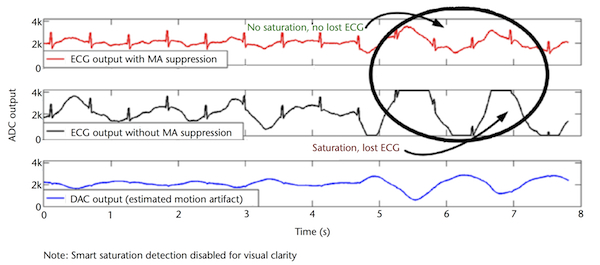TDF Circuits #1: BASIC sets clearer path to healthcare monitoring
Wearable healthcare monitoring systems are a fast growing market, and could surge when clearer device approval regimes are introduced globally. Despite that brake on growth, companies and research organizations continue to innovate in anticipation.
The subject of the first TDF Circuits, a graphics-led series looking at innovative implementations, is a subset of the Bio-potential Acquisition ASIC (BASIC), a device targeting more accurate vital signs monitoring both when the subject is at rest and when he or she is active. Unveiled at the recent International Solid State Circuits Conference, it was developed by IMEC and KU Leuven of Belgium, and the Samsung Advanced Institute of Technology of Korea.
Our specific focus here is how the team overcame noise from motion artifacts (MAs) that can distort or make it difficult to read critical data, such as that from an ECG, while the subject is walking. Particularly novel is the way in which BASIC suppresses the MAs before analog-to-digital conversion (ADC).
The architecture is shown in Figure 1 below with results in Figure 2 (these are both complex diagrams and you can click on the versions in the body text for bigger, easier-to-review versions).
Figure 1
Architecture for motion artifact suppression with off-chip MCU. Source: IMEC/KU Leuven/SAIT
Figure 2
Results for motion artifact suppression. Source: IMEC/KU Leuven/SAIT
MA suppression is usually achieved through digital post-processing, but this requires a very large dynamic range readout circuit and this results in turn in high power dissipation due to the need for high-resolution ADCs. That is hardly ideal given the form factor, power and other demands being placed on wearable medical devices.
BASIC suppresses MAs in the analog domain, before final amplification. A least mean-square (LMS) filter estimates the MAs in the readout channel based on the electrode tissue impedance (ETI) signal. This estimation is then fed back from an off-chip MCU to the BASIC through a digital-to-analog converter (DAC).
The DAC’s output is then ‘cleaned’ from the raw ECG before final amplification by a programmable gain amplifier (PGA). The PGA has a differential difference amplification (DDA) architecture. This allows MAs to be suppressed early in the amplification chain and increases the equivalent dynamic range.
BASIC is a 160uA device that also features an instrumentation amplifier (IA) with a fully integrated 200MHz high-pass filter capable of rail-to-rail DC-offset rejection without compromising the common-mode rejection ratio (120dB).
A configurable ADC resolution and support for external sensors such as accelerometers and temperature sensors could allow BASIC to gather data from a number of health monitoring sources. The research chip has been implemented on a 180nm process.

